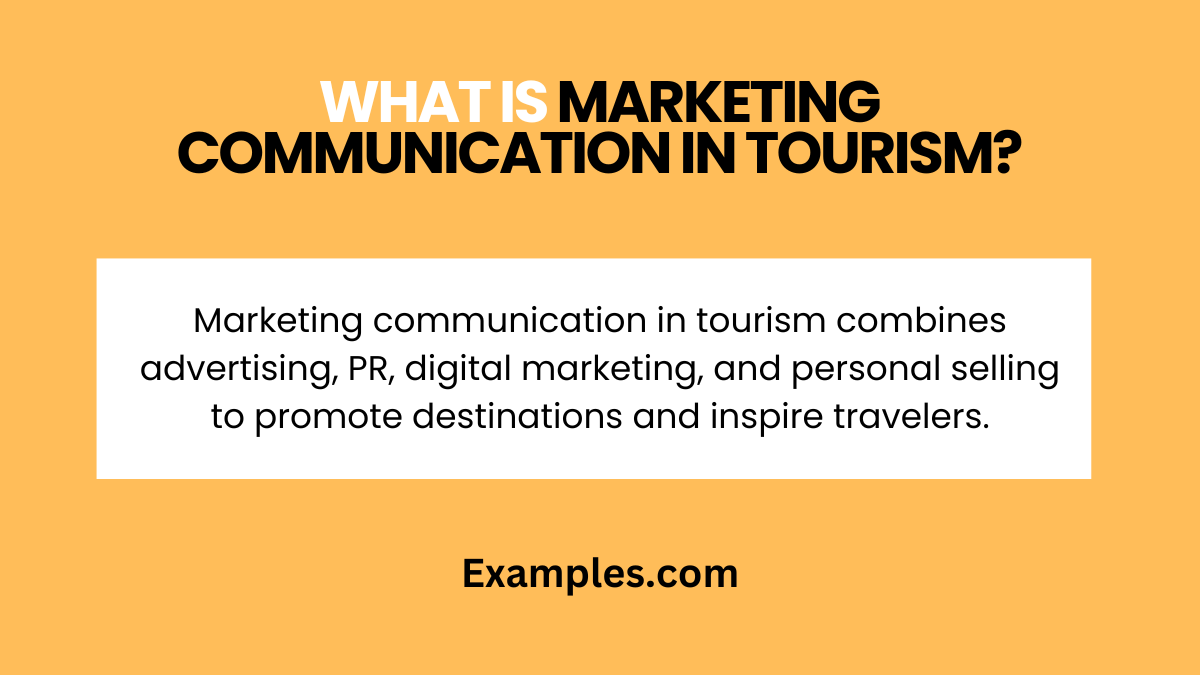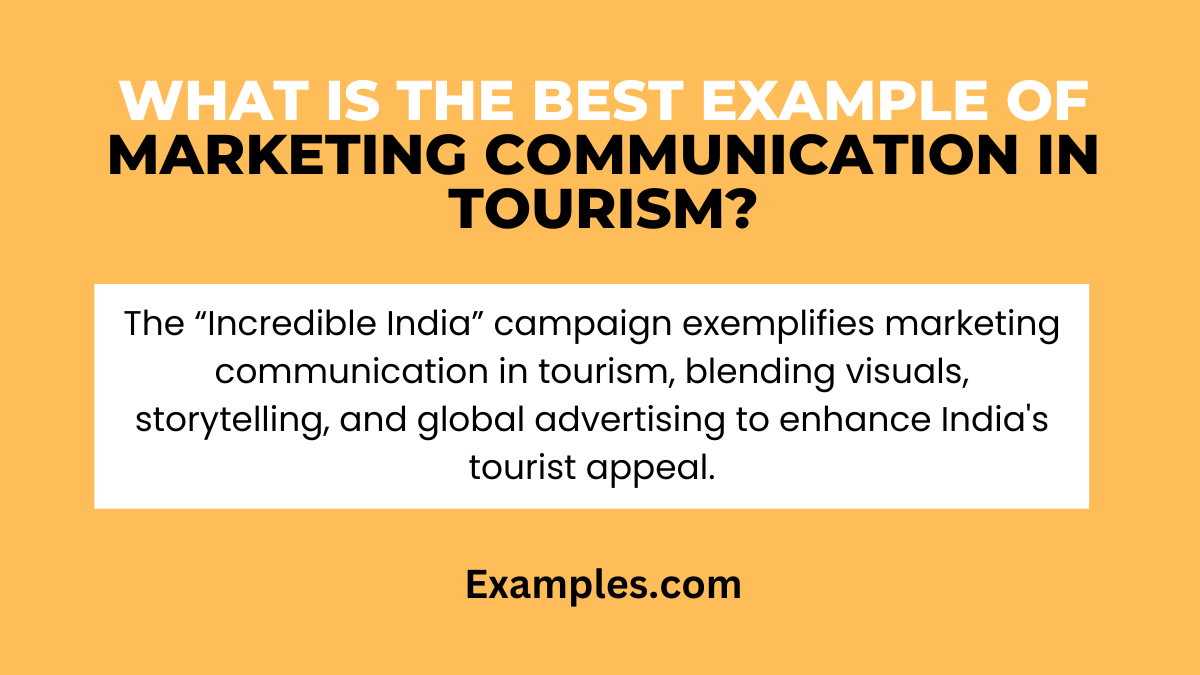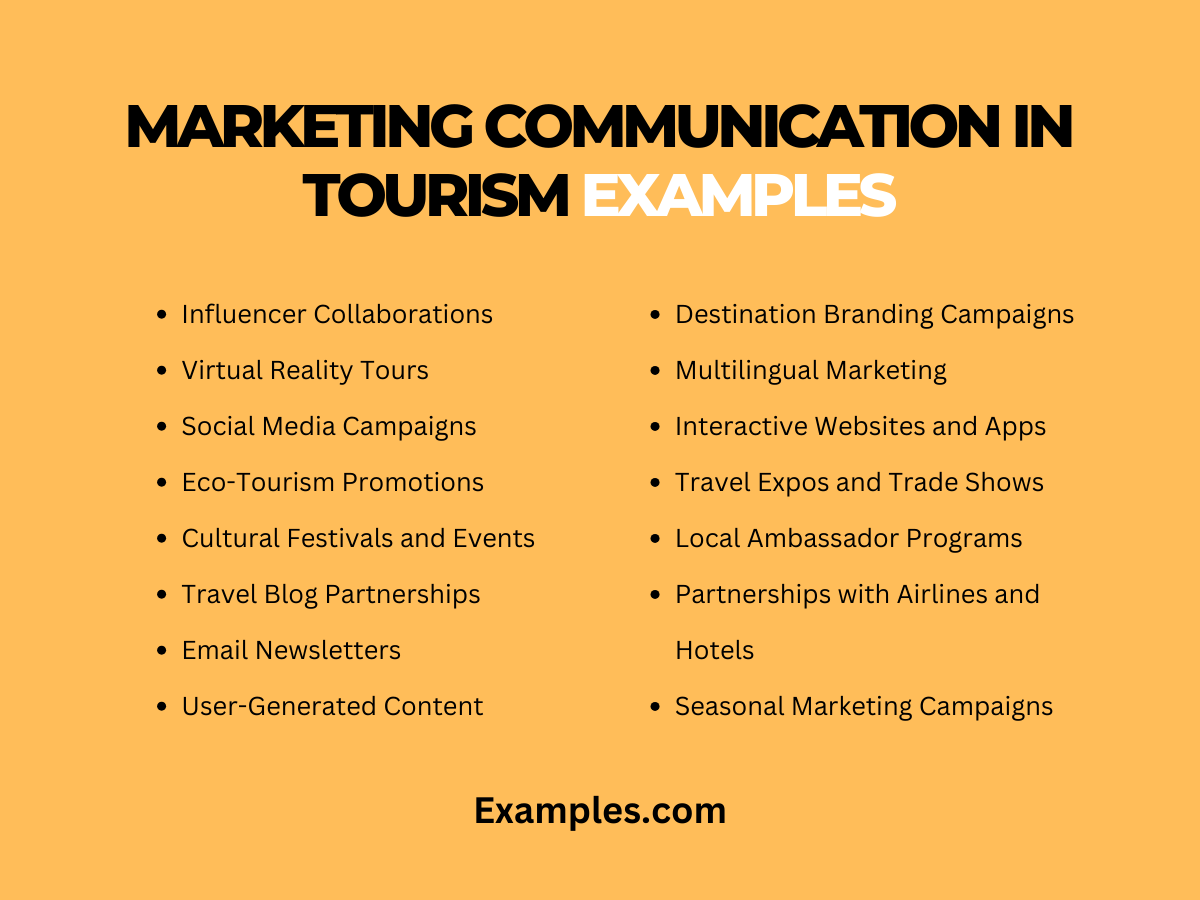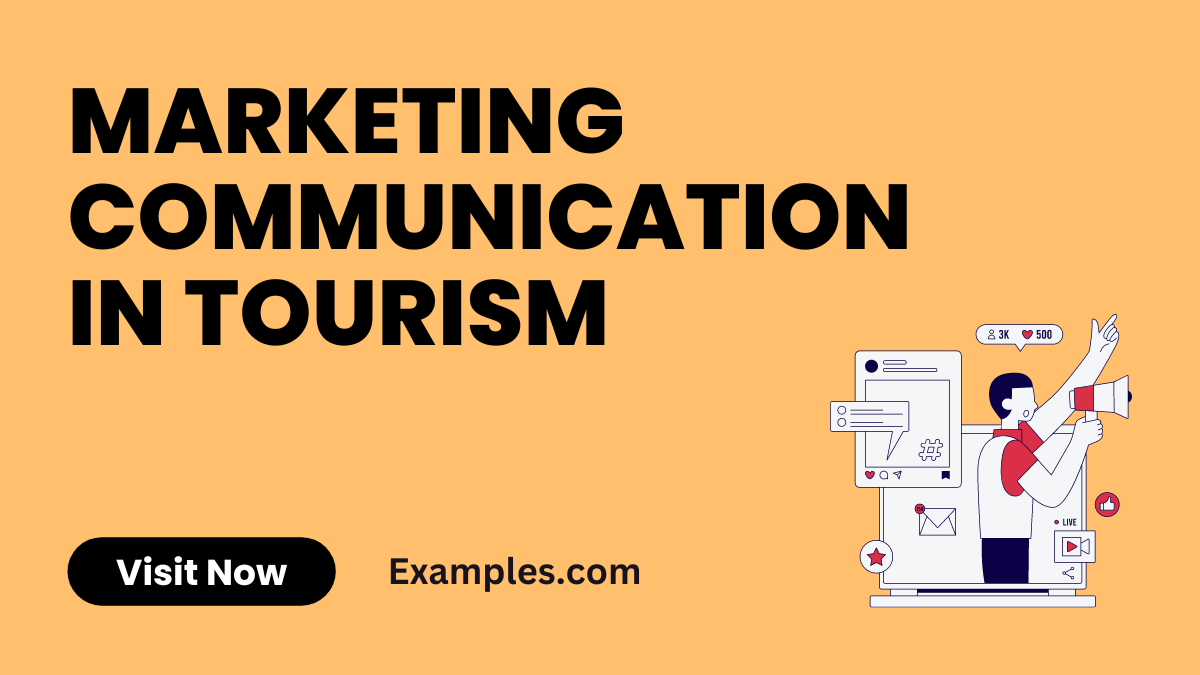14+ Marketing Communication in Tourism Examples
Dive into the engaging world of Marketing Communication in Tourism with this all-encompassing guide. In the realm of tourism, effective communication is not just about promoting destinations, but also about crafting compelling stories that resonate with travelers. This guide highlights how internal strategies and external marketing efforts converge to create unforgettable experiences and robust brand identities. From digital campaigns to immersive storytelling, each example in this guide showcases the innovative ways through which tourism entities can connect with their audience, elevate their brand, and enhance the overall travel experience.
What is Marketing Communication in Tourism?

Marketing Communication in Tourism refers to the strategies and techniques used by tourism businesses and organizations to promote destinations, services, and experiences to potential travelers. It involves a combination of advertising, public relations, digital marketing, and personal selling to create a cohesive and appealing image of a destination or service. Effective marketing communication in tourism is not only about disseminating information but also about engaging and inspiring potential tourists, creating a desire to experience what is being offered.
What is the Best Example of Marketing Communication in Tourism?

A prime example of Marketing Communication in Tourism is the “Incredible India” campaign. This initiative successfully blended captivating visuals, compelling storytelling, and strategic global advertising to showcase India’s diverse culture, heritage, and landscapes. By integrating traditional and digital media, the campaign reached a vast audience, creating a strong and inviting brand image of India as a tourist destination. The campaign’s use of vivid imagery, thematic storytelling, and targeted promotion exemplifies how effective marketing communication can significantly enhance tourism appeal and drive visitor engagement.
15 Marketing Communication in Tourism Examples

- Influencer Collaborations: Partnering with travel influencers to showcase destinations through authentic, relatable content.
- Example: “By collaborating with travel influencers, we showcased the hidden gems of our city, reaching a younger, adventure-seeking audience.”
- Virtual Reality Tours: Offering immersive VR experiences to give potential tourists a taste of the destination.
- Example: “Our VR tour lets travelers experience the Northern Lights from their homes, sparking interest in visiting our country.”
- Social Media Campaigns: Utilizing platforms like Instagram and TikTok to highlight unique aspects of a destination.
- Example: “Our #HiddenBeaches campaign on Instagram showcased lesser-known coastal spots, driving up interest among beach lovers.”
- Eco-Tourism Promotions: Marketing communication focused on sustainable and eco-friendly travel experiences.
- Example: “Our eco-tours highlight sustainability, attracting environmentally conscious travelers to our rainforest retreats.”
- Cultural Festivals and Events: Promoting local festivals and events to attract tourists seeking cultural experiences.
- Example: “Advertising our annual Jazz Festival internationally attracted music enthusiasts from around the globe.”
- Travel Blog Partnerships: Collaborating with travel bloggers to create detailed guides and articles about destinations.
- Example: “Partnering with well-known travel bloggers, we created comprehensive guides to our city’s hidden culinary spots.”
- Email Newsletters: Sending targeted newsletters to inform subscribers about new attractions, deals, and travel tips.
- Example: “Our monthly newsletter keeps subscribers updated on the latest events and exclusive travel deals.”
- User-Generated Content: Encouraging tourists to share their experiences on social media to enhance authenticity.
- Example: “Our #MyTravelStory campaign generated authentic content from tourists, adding credibility to our destination.”
- Destination Branding Campaigns: Creating a unique brand image for a destination through strategic marketing.
- Example: “Our ‘Island of Adventure’ campaign rebranded our destination as a hotspot for thrill-seekers.”
- Multilingual Marketing: Using multiple languages in marketing materials to attract a diverse international audience.
- Example: “Our multilingual brochures and website cater to tourists from various linguistic backgrounds, ensuring inclusivity.”
- Interactive Websites and Apps: Developing engaging online platforms that offer extensive information and booking options.
- Example: “Our interactive website features 360-degree tours, making it easier for travelers to plan their visit.”
- Travel Expos and Trade Shows: Participating in global travel expos to network and promote destinations.
- Example: “Our presence at international travel expos has significantly increased our visibility among global travelers.”
- Local Ambassador Programs: Engaging local residents as ambassadors to share authentic experiences with tourists.
- Example: “Our Local Ambassador program lets visitors experience our city through the eyes of a resident.”
- Partnerships with Airlines and Hotels: Collaborating with airlines and hotels for joint promotions and packages.
- Example: “Collaborating with airlines, we offer special flight and accommodation packages, making travel more accessible.”
- Seasonal Marketing Campaigns: Tailoring marketing efforts to highlight seasonal attractions and activities.
- Example: “Our winter campaign focuses on our ski resorts and cozy mountain lodges, attracting winter sports enthusiasts.”
Integrated Marketing Communication in Tourism
- Unified Message Across Channels: IMC ensures that whether through social media, brochures, or advertisements, the core message about the destination remains consistent, reinforcing the brand identity.
- Target Audience Engagement: By using a mix of channels tailored to the audience – from traditional mass communication to digital communication – IMC effectively engages diverse groups of potential tourists.
- Strategic Brand Positioning: IMC aids in positioning the tourism brand in the minds of consumers, using a combination of advertising, public relations, and promotional activities to convey the unique selling points of the destination.
- Cost-Effectiveness: By integrating various communication efforts, IMC can be more cost-effective, eliminating redundancy and maximizing the impact of the marketing budget.
- Measurement and Adaptation: IMC allows for the monitoring of campaign effectiveness across different channels, enabling tourism organizations to adapt strategies based on performance and feedback.
Modern Marketing Communication in Tourism
The landscape of Modern Marketing Communication in Tourism is continuously evolving, heavily influenced by technological advancements and changing consumer behaviors.
- Digital Transformation: The rise of digital communication channels, such as social media, websites, and mobile apps, has revolutionized how tourism entities communicate with potential travelers.
- Personalization and Customization: Utilizing data analytics and AI, modern marketing strategies are increasingly personalized, catering to the specific preferences and behaviors of individual travelers.
- Content Marketing: Engaging, informative, and inspirational content plays a key role in modern marketing, helping to tell the story of a destination and create emotional connections with audiences.
- Influencer Marketing: Collaborations with influencers and content creators provide a way to reach wider audiences in a more authentic and relatable manner.
- Sustainability and Responsibility: Modern marketing also emphasizes sustainable and responsible tourism, aligning with the growing consumer preference for environmentally and socially conscious travel options.
What are the Marketing Communication Tools Used by Tourism Organizations?
Tourism organizations utilize a variety of marketing communication tools to effectively reach and engage their target audience.
- Social Media Platforms: Tools like Instagram, Facebook, and Twitter are crucial for real-time engagement, showcasing destinations, and leveraging user-generated content.
- Content Management Systems (CMS): These are used for creating and managing digital content such as blogs, which are integral for SEO and online visibility.
- Email Marketing Software: For sending newsletters, promotions, and personalized communication to potential and returning tourists.
- Analytics and Data Tools: Tools like Google Analytics help in tracking the performance of marketing campaigns and understanding visitor behaviors and preferences.
- CRM Systems: Customer Relationship Management systems are vital for managing interactions with past, current, and potential customers, enhancing customer service and relationship marketing.
What are the Key Components of a Successful Tourism Marketing Communication Strategy?
A successful Tourism Marketing Communication Strategy hinges on several key components that ensure its effectiveness and impact.
- Clear Objectives and Goals: Defining what the marketing efforts aim to achieve, whether it’s increasing visitor numbers, promoting off-season travel, or enhancing destination branding.
- Understanding the Target Audience: A deep understanding of the target market, including their preferences, behaviors, and travel motivations, is essential for creating relevant and appealing communication.
- Content Strategy: Developing a content strategy that resonates with the target audience, utilizing storytelling, visuals, and engaging narratives about the destination.
- Multi-Channel Approach: Implementing a multi-channel strategy that combines various forms of communication, from digital to traditional media, to reach a broader audience.
- Monitoring and Evaluation: Continuously monitoring the performance of marketing activities and being flexible enough to adapt strategies based on feedback and market trends.
In conclusion, this guide has explored the dynamic landscape of Marketing Communication in Tourism, offering a wealth of examples and strategic insights. Emphasizing the importance of integrated, modern approaches and diverse tools, it highlights how effective communication can elevate tourism experiences and brands. These tips and examples serve as a roadmap for crafting impactful and engaging marketing strategies in the ever-evolving tourism industry.



